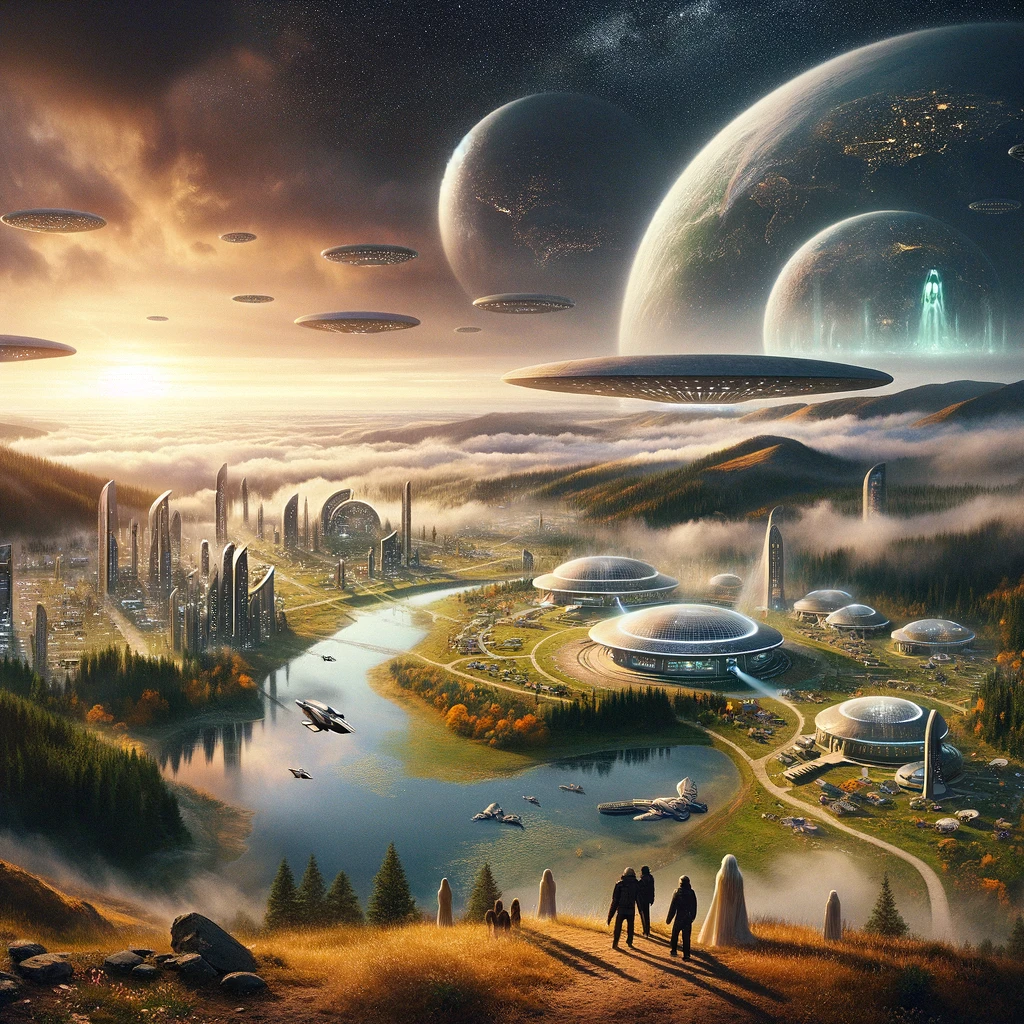Childhood’s End

Arthur C. Clarke’s Childhood’s End is a science fiction novel that explores the transcendence and evolution of humanity through the intervention of alien beings known as the Overlords. Set in the near future, the novel begins with the peaceful arrival of the Overlords, whose superior technology and intelligence transform Earth into a utopian society. Poverty, war, and disease are eradicated, and humanity enters an unprecedented era of peace and prosperity. However, Clarke’s narrative emphasizes that this peace comes at the cost of human individuality, creativity, and self-determination. The Overlords, while benevolent, exercise control over humanity’s development, steering them toward a collective destiny rather than allowing them to chart their own path.
A central aspect of Childhood’s End is the role children play in this transformation. Clarke presents the younger generation as the key to humanity’s evolutionary leap, as they begin to display extraordinary psychic abilities that signal their transition into a higher state of being. These children eventually outgrow their human origins, leaving behind their parents and the rest of humanity, who remain unable to partake in this evolutionary shift. This generational divide is a significant theme in the book, illustrating the notion that the future belongs to the next stage of human evolution, which will transcend the limitations of individuality and personal identity. The children’s ultimate merging with the Overmind, a vast cosmic intelligence, signifies the end of humanity as a distinct species, marking the novel’s titular “end of childhood.”
The Overlords, central to the plot, serve as guides for humanity’s development. Interestingly, their physical appearance, which resembles traditional depictions of demons, plays a crucial role in the story. This appearance challenges humanity’s deeply ingrained psychological and mythological fears, as people initially hesitate to trust beings that resemble devils. Clarke uses this symbolic imagery to explore how humans judge others based on appearance, contrasting the Overlords’ outwardly frightening form with their true, benevolent intentions. This aspect of the novel encourages readers to question their own perceptions of good and evil, reinforcing one of Clarke’s recurring themes: the deceptive nature of appearances.
While the novel depicts the utopian society brought about by the Overlords, Clarke doesn’t shy away from addressing the potential drawbacks of such a world. The peace and stability created by the Overlords also stifle humanity’s drive for innovation, exploration, and creative expression. As humanity grows complacent in this seemingly perfect world, their individuality and ambition are diminished. Clarke questions whether a world without conflict or struggle is truly desirable, suggesting that the very qualities that make humans unique—their quest for knowledge, self-determination, and creativity—are sacrificed in exchange for comfort and security. The novel’s portrayal of this utopia is therefore ambivalent, highlighting both its benefits and its costs.
The novel’s tone grows increasingly tragic as the story progresses, particularly as it becomes clear that humanity’s destiny is to be subsumed into the Overmind. While this represents an evolutionary leap, it also signifies the extinction of humanity as an independent species. Clarke’s depiction of this transition is bittersweet, conveying both a sense of awe at the grandeur of the Overmind and sorrow for the loss of human distinctiveness. The merging with the Overmind is portrayed not as a simple triumph, but as a complex, emotionally charged process that comes with existential and emotional sacrifices. Humanity, as it has existed for millennia, ceases to be, replaced by something both greater and less human.
Jan Rodricks, the novel’s final human protagonist, serves as a poignant counterpoint to this collective evolution. Driven by a deep curiosity, Jan stows away on an alien ship to travel to the Overlords’ home planet, becoming the last human to witness Earth’s final days. His journey reflects humanity’s enduring quest for knowledge, even in the face of overwhelming odds. However, his return to a radically transformed Earth leaves him isolated and alone, a relic of a bygone era. Jan’s loneliness and sense of loss underscore the emotional toll of humanity’s evolutionary end, providing a personal lens through which the reader can understand the broader themes of change and sacrifice that permeate the novel.
Throughout Childhood’s End, Clarke weaves in religious and mythological themes, particularly in the concept of transcendence. The children’s merging with the Overmind can be seen as a form of ascension, akin to religious interpretations of spiritual enlightenment or the attainment of divinity. At the same time, the Overlords, despite their immense power, are unable to join the Overmind and remain tragically excluded from this higher plane of existence. This contrast between the Overlords and humanity raises questions about the nature of gods and overseers, and the limits of power and knowledge. Clarke’s exploration of these themes adds a philosophical depth to the narrative, inviting readers to reflect on humanity’s place in the universe and the possibility of greater forms of existence beyond the physical realm.
In conclusion, Arthur C. Clarke’s Childhood’s End is a rich and thought-provoking exploration of humanity’s future, the tension between individuality and collective existence, and the costs of progress. Through its complex narrative and philosophical themes, the novel challenges readers to consider the ultimate destiny of humankind and the profound sacrifices that accompany transcendence. Clarke masterfully blends science fiction with existential and philosophical questions, creating a timeless work that continues to resonate with readers today.


